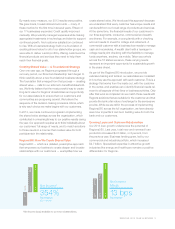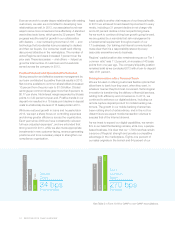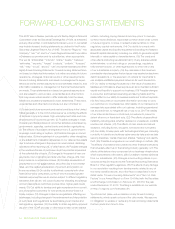Regions Bank 2013 Annual Report Download - page 18
Download and view the complete annual report
Please find page 18 of the 2013 Regions Bank annual report below. You can navigate through the pages in the report by either clicking on the pages listed below, or by using the keyword search tool below to find specific information within the annual report.
16 REGIONS 2013 YEAR IN REVIEW
FORWARD-LOOKING STATEMENTS
This 2013 Year in Review, periodic reports filed by Regions Financial
Corporation under the Securities Exchange Act of 1934, as amended,
and any other written or oral statements made by us or on our behalf
may include forward-looking statements as defined in the Private
Securities Litigation Reform Act of 1995. The terms “Regions,” “the
Company,” “we,” “us” and “our” mean Regions Financial Corporation,
a Delaware corporation and its subsidiaries, when appropriate.
The words “anticipates,” “intends,” “plans,” “seeks,” “believes,”
“estimates,” “expects,” “target,” “projects,” “outlook,” “forecast,”
“will,” “may,” “could,” “should,” “can” and similar expressions often
signify forward-looking statements. Forward-looking statements are
not based on historical information, but rather are related to future
operations, strategies, financial results or other developments.
Forward-looking statements are based on management’s expec-
tations as well as certain assumptions and estimates made by, and
information available to, management at the time the statements
are made. Those statements are based on general assumptions
and are subject to various risks, uncertainties and other factors
that may cause actual results to differ materially from the views,
beliefs and projections expressed in such statements. These risks,
uncertainties and other factors include, but are not limited to:
(1) Current and future economic and market conditions in the United
States generally or in the communities we serve, including the effects
of declines in property values, high unemployment rates and over-
all slowdowns in economic growth. (2) Possible changes in trade,
monetary and fiscal policies of, and other activities undertaken by,
governments, agencies, central banks and similar organizations.
(3) The effects of a possible downgrade in the U.S. government’s
sovereign credit rating or outlook. (4) Possible changes in market
interest rates. (5) Any impairment of our goodwill or other intangibles,
or any adjustment of valuation allowances on our deferred tax assets
due to adverse changes in the economic environment, declining
operations of the reporting unit, or other factors. (6) Possible changes
in the creditworthiness of customers and the possible impairment
of the collectability of loans. (7) Changes in the speed of loan pre-
payments, loan origination and sale volumes, charge-offs, loan
loss provisions or actual loan losses. (8) Possible acceleration of
prepayments on mortgage-backed securities due to low interest
rates, and the related acceleration of premium amortization on
those securities. (9) Our ability to effectively compete with other
financial services companies, some of whom possess greater
financial resources than we do and are subject to different regulatory
standards than we are. (10) Loss of customer checking and savings
account deposits as customers pursue other, higher-yield invest-
ments. (11) Our ability to develop and gain acceptance from current
and prospective customers for new products and services in a
timely manner. (12) Changes in laws and regulations affecting our
businesses, including changes in the enforcement and interpretation
of such laws and regulations by applicable governmental and
self-regulatory agencies. (13) Our ability to obtain regulatory approval
(as part of the CCAR process or otherwise) to take certain capital
actions, including paying dividends and any plans to increase
common stock dividends, repurchase common stock under current
or future programs, or issue or redeem preferred stock or other
regulatory capital instruments. (14) Our ability to comply with
applicable capital and liquidity requirements (including the finalized
Basel III capital standards), including our ability to generate capital
internally or raise capital on favorable terms. (15) The costs and
other effects (including reputational harm) of any adverse judicial,
administrative, or arbitral rulings or proceedings, regulatory
enforcement actions, or other legal actions to which we or any
of our subsidiaries is a party. (16) Any decrease in the maximum
permissible interchange fee that an issuer may receive for electronic
debit transactions, or the expansion of options for merchants to
use multiple unaffiliated payment networks for each transaction.
(17) Our ability to manage fluctuations in the value of assets and
liabilities and off-balance sheet exposure so as to maintain sufficient
capital and liquidity to support our business. (18) Possible changes
in consumer and business spending and saving habits and the
related effect on our ability to increase assets and to attract deposits.
(19) Any inaccurate or incomplete information provided to us by
our customers or counterparties. (20) Inability of our framework to
manage risks associated with our business, including operational
risk and credit risk, to mitigate all risk or loss to us. (21) The inability
of our internal disclosure controls and procedures to prevent or
detect all errors or fraudulent acts. (22) The effects of geopolitical
instability, including wars (whether declared or undeclared), conflicts
and terrorist attacks. (23) The effects of man-made and natural
disasters, including floods, droughts, tornadoes and hurricanes.
(24) Our ability to keep pace with technological changes, including
our ability to identify and address cyber-security risks such as data
security breaches, “denial of service” attacks, “hacking” and identity
theft. (25) Possible downgrades in our credit ratings or outlook. (26)
The effects of problems encountered by other financial institutions
that adversely affect us or the banking industry generally. (27) The
effects of the failure of any component of our business infrastructure
which is provided by a third party. (28) Our ability to receive dividends
from our subsidiaries. (29) Changes in accounting policies or pro-
cedures as may be required by the Financial Accounting Standards
Board or other regulatory agencies. (30) The effects of any damage
to our reputation resulting from developments related to any of
the items identified above; and other factors described in more
detail under “Forward Looking Statements” and “Item 1A. Risk
Factors” in our Annual Report on Form 10-K filed with the Securities
and Exchange Commission on February 21, 2014 for the year
ended December 31, 2013. This filing is available on our website
at http://ir.regions.com/financials.cfm.
You should not place undue reliance on any forward-looking
statements, which speak only as of the date made. We assume
no obligation to update or revise any forward-looking statements
that are made from time to time.
















